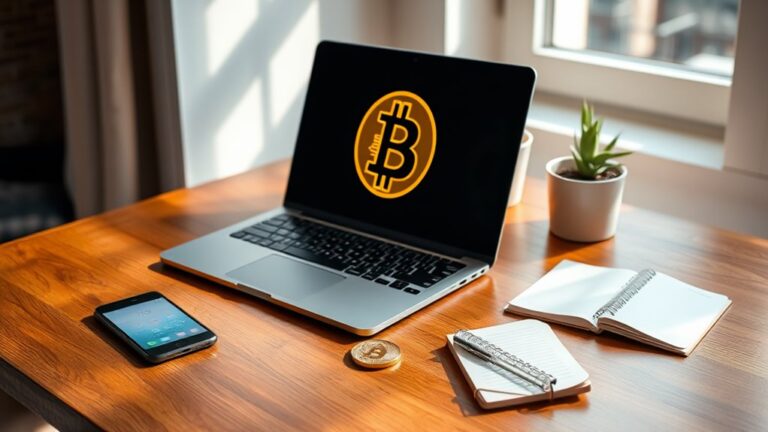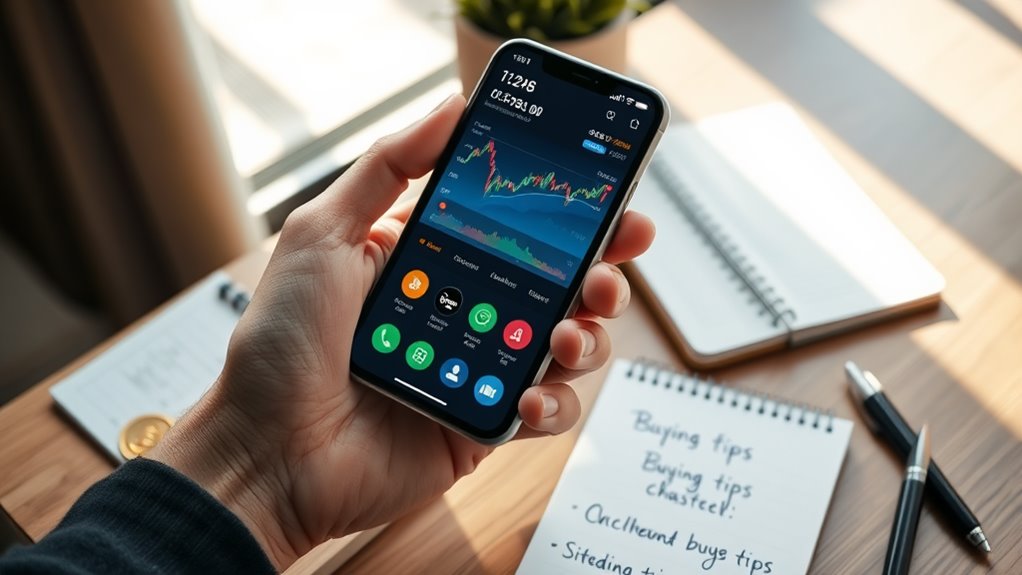
How to Buy Bitcoin: Step-by-Step Guide
Buying Bitcoin requires several straightforward steps. First, select a reputable exchange like Coinbase or Binance based on security features and fee structures. Create an account and complete identity verification by submitting required documents. Set up a crypto wallet for storage—hardware wallets offer maximum security for larger investments. Fund your exchange account using bank transfers or debit cards, then place a market or limit order to purchase Bitcoin. The following guide explores each step in thorough detail.
Key Takeaways
- Select a reputable exchange platform like Kraken or Binance based on security features, fees, and available cryptocurrencies.
- Complete identity verification by submitting government IDs and passing facial verification to comply with regulations.
- Fund your trading account through bank transfers, credit/debit cards, or cryptocurrency deposits depending on your fee preferences.
- Purchase Bitcoin using market orders for immediate execution or limit orders to buy at specific price targets.
- Transfer your Bitcoin to a secure wallet (hardware wallets like Ledger or Trezor recommended for large amounts).
Understanding Bitcoin Basics Before Investing
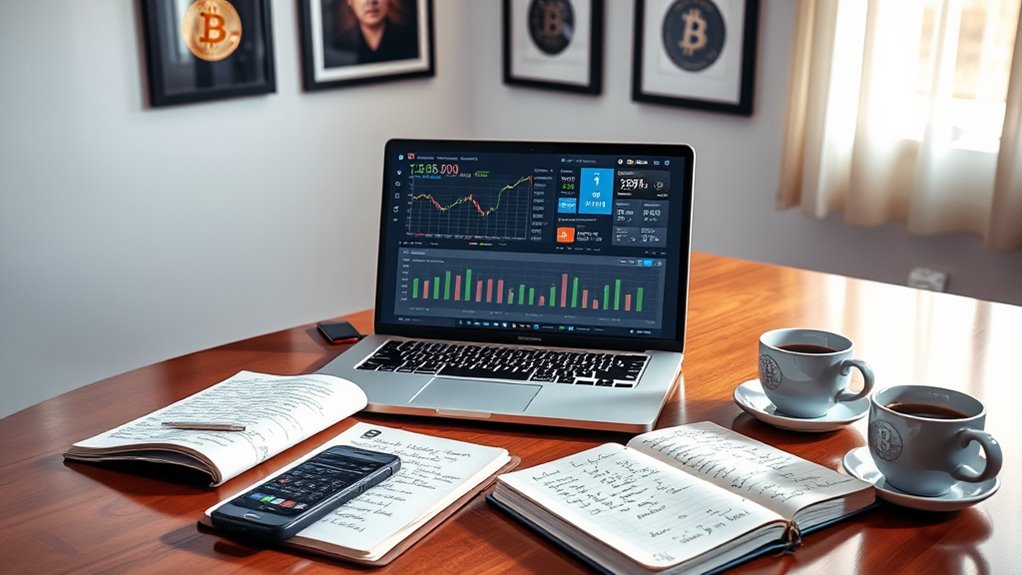
Before venturing into the world of cryptocurrency investment, understanding the fundamental principles of Bitcoin can greatly improve one's decision-making process.
Bitcoin operates as a decentralized digital currency, functioning independently of central financial authorities through blockchain technology. This distributed ledger records all transactions across a network of computers, ensuring transparency and security.
Bitcoin's revolutionary decentralized design removes intermediaries, leveraging blockchain to create transparent financial freedom.
Bitcoin has a finite supply of 21 million coins, which are generated through a mining process involving complex cryptographic puzzles. All transactions are secured using cryptographic keys and can be verified by anyone due to the public nature of the blockchain.
The system maintains integrity through a proof-of-work consensus mechanism. When considering Bitcoin as an investment, it's important to recognize its significant price volatility and understand the regulatory environment in your jurisdiction.
For those new to digital currencies, learning about key terminology can help clarify the innovative financial concepts behind cryptocurrency.
Selecting the Right Exchange Platform
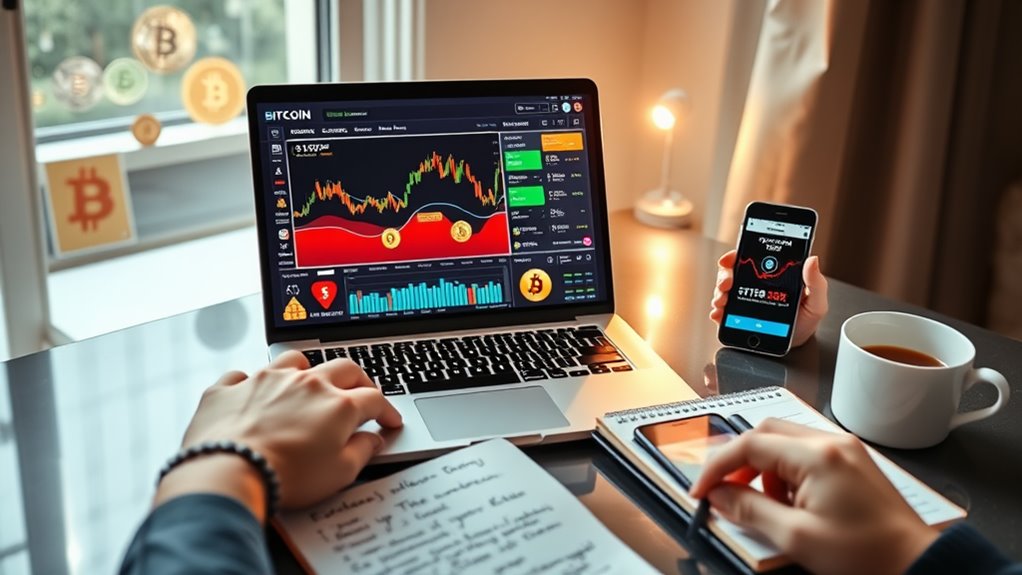
Selecting the right cryptocurrency exchange platform requires consideration of several key criteria, including reputation, security features, and user base size.
When comparing platforms, investors should examine fee structures, noting that exchanges like Kraken and Bitpanda offer competitive rates while others vary based on transaction type.
While security-focused platforms like Gemini provide robust protection measures, users must balance these benefits against usability factors such as interface design and mobile app functionality.
Understanding the difference between centralized vs decentralized exchanges is crucial when selecting a platform that aligns with your trading goals and security preferences.
Key Platform Criteria
Numerous factors come into play when evaluating cryptocurrency exchange platforms for Bitcoin purchases.
Security measures like two-factor authentication, cold storage, and multi-signature wallets represent essential protective elements for user funds.
User interface quality greatly impacts trading experiences, with intuitive design and real-time market data enabling informed decisions.
An exchange's reputation, established through historical performance and regulatory compliance, provides indicators of trustworthiness.
The variety of available cryptocurrencies and trading pairs offers flexibility, especially important for traders seeking diverse investment options.
Additionally, robust customer support services—preferably available 24/7 through multiple channels—ensure assistance when technical issues arise.
Beginners should prioritize exchanges offering comprehensive educational resources that explain cryptocurrency concepts and trading fundamentals.
These criteria collectively help prospective Bitcoin buyers select platforms aligned with their specific needs, risk tolerance, and trading preferences.
Fee Structure Comparison
Understanding fee structures represents one of the most significant financial considerations when choosing a Bitcoin exchange platform. Exchanges typically charge different rates for makers (who add liquidity) and takers (who remove it), with maker fees generally lower.
Major platforms vary considerably in their fee approaches. Binance charges a base fee of 0.1% but offers a 25% discount when paying with BNB tokens. Coinbase starts at higher rates (0.4% for makers), while OKX implements a tiered system beginning at 0.08%. Some exchanges like Binance.US provide zero-fee trading on certain Bitcoin pairs.
Most platforms don't charge for crypto deposits, though fiat deposit fees vary by payment method. Trading volume, holding native tokens, and VIP programs represent effective strategies for reducing transaction costs across exchanges. Having a solid risk management technique is essential when selecting exchange platforms to ensure you're not losing significant value through excessive fees.
Security Vs Usability
The balance between security and usability represents a critical consideration when choosing a Bitcoin exchange platform. Exchanges that prioritize robust security measures may offer complex interfaces, while those focusing on user experience might compromise certain security features.
| Feature | Security-Focused | Balanced | Usability-Focused |
|---|---|---|---|
| Authentication | Multi-factor, biometrics | Two-factor (2FA) | Simple password |
| Interface | Complex, detailed | Moderately intuitive | Streamlined, simple |
| Withdrawal Process | Multiple verifications | Basic verification | Quick, minimal steps |
| Support Options | Limited, technical | Thorough | Extensive, 24/7 |
When selecting an exchange, assess your technical comfort level against security needs. Beginners might prefer platforms with intuitive interfaces and strong customer support, while experienced users may value advanced security features like multi-signature wallets and encryption, despite steeper learning curves. Once purchased, transferring your Bitcoin to a cold wallet solution provides significantly enhanced security by storing your private keys completely offline and away from potential online threats.
Creating and Securing Your Crypto Wallet
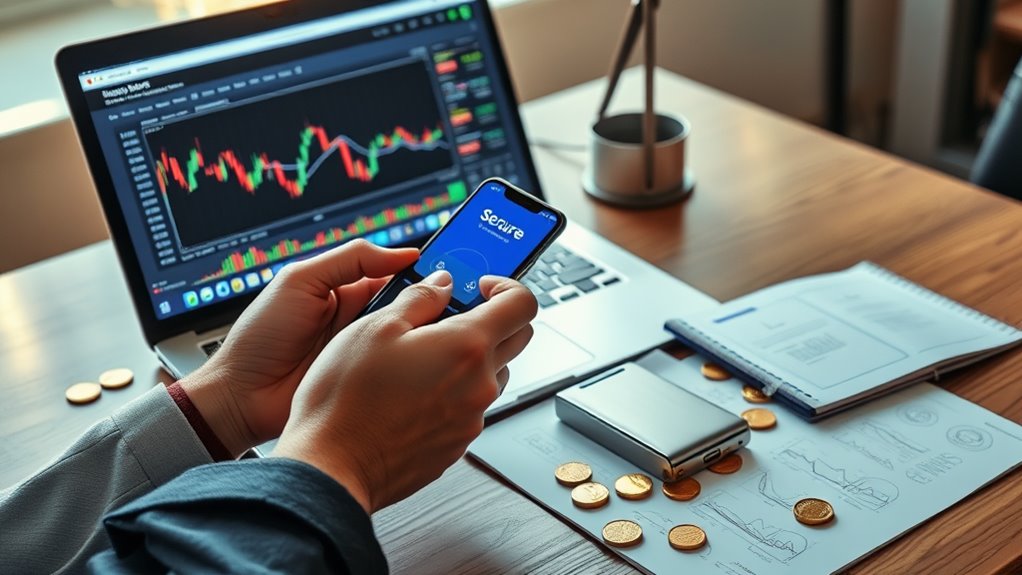
Setting up a secure cryptocurrency wallet represents the crucial first step in your Bitcoin investment journey. Wallets come in different forms, each with varying levels of security and convenience. When selecting a wallet, users should consider whether they prefer complete control of their keys (noncustodial) or third-party management (custodial).
Your cryptocurrency journey begins with wallet selection—choose between self-custody or managed security based on your comfort level.
For peak wallet security, follow these essential practices:
- Store recovery phrases in a fireproof box or safe, never digitally
- Enable two-factor authentication (2FA) for all wallet access
- Regularly update wallet software to maintain security patches
- Consider using a hardware wallet like Ledger or Trezor for significant holdings
- Create strong, unique passwords combining letters, numbers, and symbols
Remember that hot wallets offer convenience but less security, while cold wallets provide enhanced protection by remaining offline, making them ideal for long-term storage. For additional protection of substantial cryptocurrency holdings, multi-signature options require multiple private keys to authorize transactions, significantly reducing the risk of unauthorized access.
Completing Identity Verification Requirements

Before investors can purchase Bitcoin on reputable cryptocurrency exchanges, they must complete a thorough identity verification process known as KYC (Know Your Customer). This mandatory verification typically follows a tiered structure, with each level granting increased trading capabilities.
The process generally begins with basic information verification (email and phone number), followed by document submission where users upload government-issued IDs like passports or driver's licenses. Many platforms also require facial verification through selfies taken in well-lit environments without obstructions.
This verification serves multiple purposes: preventing fraud, protecting users' assets, ensuring platform integrity, and maintaining regulatory compliance.
While the process might seem cumbersome, it ultimately creates a more secure trading environment and builds trust between users and cryptocurrency exchanges. These verification requirements reflect the broader trend of regulatory approaches that aim to legitimize cryptocurrencies while preventing their use in illicit activities.
Depositing Funds and Placing Your First Bitcoin Order
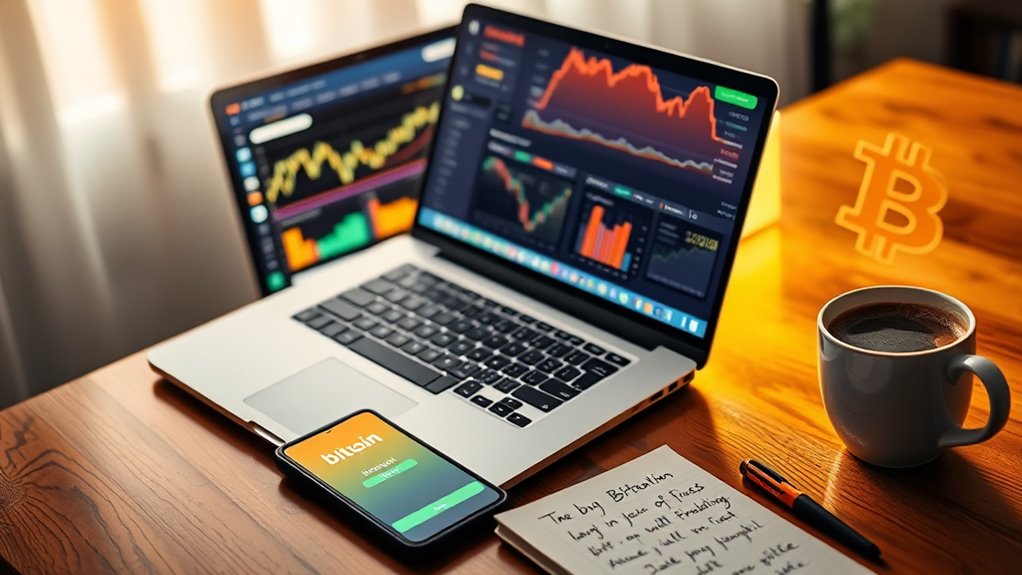
Once identity verification is completed, customers must fund their trading account through one of several available methods, including bank transfers, debit cards, or regional options like SEPA in Europe.
After funds appear in the account, traders can purchase Bitcoin through either market orders, which execute immediately at current prices, or limit orders, which allow setting a specific purchase price that executes only when the market reaches that level.
The choice between order types depends on personal preference, with market orders providing convenience and immediacy while limit orders offer price control at the expense of guaranteed execution.
Credit cards provide another popular funding option, though they typically incur higher transaction fees compared to other payment methods.
Fund Your Account
After completing the account setup process, users will need to fund their accounts before purchasing Bitcoin. Most exchanges offer several methods to deposit funds, each with different processing times and fee structures.
- Bank transfers typically involve minimal fees but may take 1-5 business days to process.
- Credit/debit cards provide instant funding but often come with higher transaction fees (3-5%).
- Third-party payment services offer alternative funding options with varying fee structures.
- Cryptocurrency deposits allow direct transfers from existing wallets with minimal fees.
- Wire transfers support larger deposit amounts but may include bank processing fees.
Each exchange has specific minimum deposit requirements and transaction limits that users should review before initiating a transfer.
For beginners, starting with smaller amounts is advisable while becoming familiar with the platform's interface and functionality.
Understanding blockchain technology is essential when making cryptocurrency transactions as it provides the secure, decentralized ledger that records and verifies all Bitcoin purchases.
Market vs. Limit Orders
Placing a Bitcoin order requires understanding the two primary transaction methods available on cryptocurrency exchanges. Market orders execute instantly at the current best price, prioritizing speed over precision. Limit orders, by contrast, let traders set their desired price, executing only when that price is reached. New investors should first establish a secure digital wallet before attempting any transactions on an exchange.
| Feature | Market Orders | Limit Orders |
|---|---|---|
| Execution | Immediate | When price conditions are met |
| Price Control | None (best available) | User-specified exact price |
| Best Use Case | Fast-moving markets | Precise price targets |
| Risk Factor | Potential slippage | May never execute |
When buying Bitcoin, market orders are ideal for quick purchases regardless of small price variations. Limit orders are better suited for strategic buying at specific price targets. Your choice should align with your investment strategy and market conditions.
Storing Bitcoin Safely After Purchase

The security of your Bitcoin assets represents one of the most critical considerations following any cryptocurrency purchase. Proper storage methods considerably reduce the risk of theft, loss, or unauthorized access.
Cold storage options like hardware wallets offer superior protection by keeping private keys offline and away from potential online threats.
- Hardware wallets such as Ledger or Trezor provide robust offline security for long-term holdings
- Paper wallets store keys in physical form but require careful protection from damage
- Multi-signature wallets add security by requiring multiple keys for transaction approval
- Regular backups prevent catastrophic loss if primary storage methods fail
- Cold storage solutions keep assets offline, markedly reducing vulnerability to hacking
Remember to diversify storage methods based on usage needs—keeping smaller amounts in more accessible wallets for transactions while securing larger holdings in cold storage.
Alternative Ways to Invest in Bitcoin

While securing your Bitcoin holdings remains important, investors should also consider various alternative approaches to participating in the Bitcoin market.
Bitcoin ETFs offer regulated exposure through traditional stock exchanges, often with security benefits like professional custody and insurance.
Investors can gain indirect Bitcoin exposure through publicly traded companies like Coinbase or MicroStrategy that hold significant Bitcoin reserves or operate in the cryptocurrency space.
Mining companies provide another equity-based option.
For those seeking lower-commitment entry points, several platforms offer Bitcoin rewards through loyalty programs, educational initiatives, or referral systems.
Financial services like PayPal and Cash App have integrated Bitcoin purchasing capabilities, making acquisition more convenient.
Decentralized exchanges (DEXes) and peer-to-peer platforms present alternatives to traditional centralized exchanges, potentially offering enhanced privacy and flexibility for transactions.
Frequently Asked Questions
How Does Bitcoin Taxation Work in Different Countries?
Bitcoin taxation varies greatly worldwide. Some countries like Germany and El Salvador offer tax exemptions, while others impose capital gains taxes ranging from 10% to 55%, depending on holding periods and transaction types.
Can I Buy Bitcoin Anonymously Despite KYC Requirements?
Anonymous Bitcoin acquisition remains possible despite KYC requirements. Through P2P platforms, certain BTMs, DEXs, and cash-by-mail services, individuals can purchase cryptocurrency with limited identity exposure, though these methods often carry increased risks and costs.
What Happens to My Bitcoin if the Exchange Goes Bankrupt?
When exchanges file for bankruptcy, customer-owned bitcoin typically becomes part of the bankruptcy estate. Investors are classified as unsecured creditors, facing delayed recovery and potentially receiving only partial repayment through court-administered claims processes.
How Do Bitcoin Inheritance Plans Work?
Bitcoin inheritance plans enable asset transfer upon death through secure key management. They utilize custodial services, non-custodial solutions, or legal frameworks to guarantee beneficiaries can access holdings while addressing tax and legal considerations.
When Is the Best Time to Buy Bitcoin?
Time is money when investing in Bitcoin. The ideal purchase periods are typically 18 months before halvings, during market consolidations after peaks, or through dollar-cost averaging to mitigate volatility's impact on long-term returns.
Conclusion
As investors navigate the cryptocurrency landscape, Bitcoin stands as both digital gold and a key to financial sovereignty. The journey from selection to secure storage mirrors the evolution of money itself—from tangible to invisible, centralized to distributed. While the path may seem complex, each step represents a building block in one's financial architecture. Like a lighthouse guiding ships, proper education illuminates the way through Bitcoin's sometimes turbulent waters.




